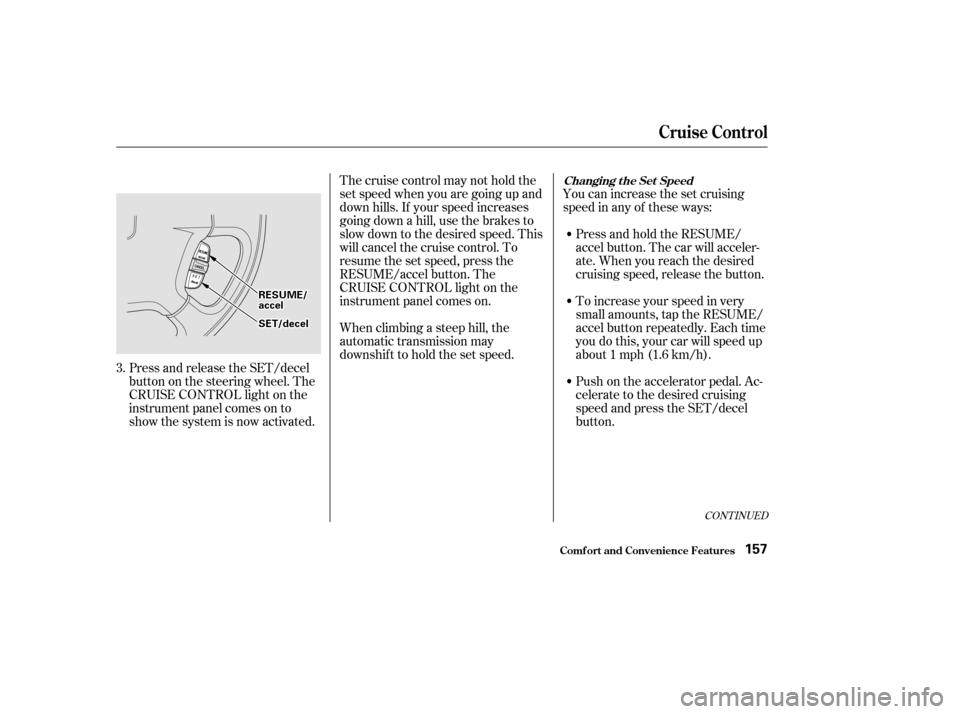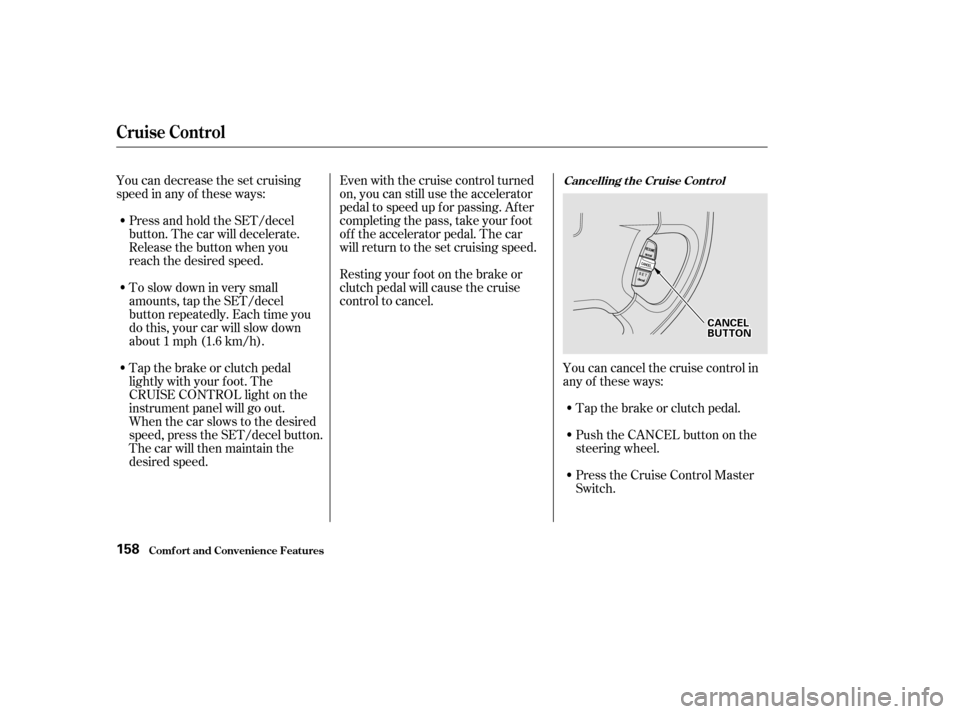Page 62 of 319

This light comes on with the high
beam headlights. See page for
inf ormation on the headlight
controls.
This lights when you set the cruise
control. See page f or inf ormation
on operating the cruise control.
On Canadian models, this indicator
comes on with reduced brightness
when the Daytime Running Lights
(DRL) are on (see page ).
See page .
The lef t or right turn signal light
blinks when you signal a lane change
or turn. If the light does not blink or
blinks rapidly, it usually means one
of the turn signal bulbs is burned out
(see page ). Replace the bulb as
soon as possible, since other drivers
cannot see that you are signalling. This light comes on if the trunk lid is
not closed tightly.
This light comes on as a reminder
that you must ref uel soon.
WhenyouturnontheHazard
Warning switch, both turn signal
lights blink. All turn signals on the
outside of the car should f lash. This light comes on when the
washer f luid level is low. Add washer
f luid when you see this light come on
(see page ).
70
71
280
248 219
76
Only on models equipped with Cruise
Control System Canadian models only
CONT INUED
High Beam Indicator
Cruise Control Indicator
Malf unction Indicator
Lamp
Turn Signal and
Hazard Warning
Indicators Low Fuel Indicator
Washer Level Indicator
Trunk-open Indicator
Indicator L ights
Inst rument s and Cont rols63
Page 68 of 319

�Î�Î
�Î
Thetwoleversonthesteering
column contain controls f or driving
f eatures you use most of ten. The lef t
lever controls the turn signals,
headlights, and high beams. The
right lever controls the windshield
washers and wipers.
The hazard warning lights switch is
on the dashboard between the
center air vents.
The controls under the lef t air vent
are f or the moonroof , mirrors and
cruise control.
The tilt adjustment lever on the
underside of the steering column
allows you to tilt the steering wheel.
To use the horn, press the center
pad of the steering wheel.
Controls Near the Steering Wheel
Inst rument s and Cont rols69
HHAAZZAARRDDWWAARRNNIINNGGLLIIGGHHTTSSMMOOOONNRROOOOFF
TTIILLTTAADDJJUUSSTTMMEENNTT
WWIINNDDSSHHIIEELLDDWWIIPPEERRSS//WWAASSHHEERRSS
MMIIRRRROORRCCOONNTTRROOLLSS
RREEAARRWWIINNDDOOWWDDEEFFOOGGGGEERR
HHEEAADDLLIIGGHHTTSS//TTUURRNNSSIIGGNNAALLSS
CCRRUUIISSEECCOONNTTRROOLLMMAASSTTEERRSSWWIITTCCHH
HHOORRNN
((PP..9944))
((PP..7700//7722))
((PP..7722//7733))
((PP..7744))
((PP..7744))
((PP..115577))
CCRRUUIISSEECCOONNTTRROOLLBBUUTTTTOONNSS
((PP..6699))
((PP..7755))
((PP..9955))
((PP..115566))
Page 102 of 319

.....................
Heating and Cooling . 104
.........
What Each Control Does . 104
............
How to Use the System . 106
..........
To Turn Everything Of f . 111
......................
Audio System (DX) . 112
.................
Operating the Radio . 112
.................
Adjusting the Sound . 116
............
Audio System Lighting . 117
..............................
Digital Clock . 117
Operating the Optional Cassette
.....................................
Player . 118
............
Tape Search Functions . 119
Operating the Optional
.............
CD Player/Changer . 121
.......
Audio System (U.S. HX, LX) . 124
.................
Operating the Radio . 124
.................
Adjusting the Sound . 128
............
Audio System Lighting . 129
..............................
Digital Clock . 129
Operating the Cassette
.....................................
Player . 130
............
Tape Search Functions . 131
Operating the Optional
.............
CD Player/Changer . 133 Audio System (U.S. EX and
...................
Canadian LX, Si) . 136
.................
Operating the Radio . 136
.................
Adjusting the Sound . 140
............
Audio System Lighting . 141
..............................
Digital Clock . 141
....................
Radio Frequencies . 142
........................
Radio Reception . 143
.........
Operating the CD Player . 145
.....
Operating the CD Changer . 147
.......
Protecting Compact Discs . 148
....
CD Player Error Indications . 149
CD Changer Error
.............................
Indications . 150
Operating the Cassette .....................................
Player . 151
............
Tape Search Functions . 152
Caring f or the Cassette
.....................................
Player . 154
.......................
Thef t Protection . 155
...............................
Cruise Control . 156
Comf ort and Convenience Features
Comf ort and Convenience Feat ures103
Page 155 of 319
Accelerate to the desired cruising
speedabove25mph(40km/h).
Push in the Cruise Control Master
Switch to the lef t of the steering
column. The indicator in the
switch will light.
Cruise control allows you to maintain
asetspeedabove25mph(40km/h)
without keeping your f oot on the
accelerator pedal. It should be used
f or cruising on straight, open
highways. It is not recommended f or
conditions such as city driving,
winding roads, slippery roads, heavy
rain, or bad weather. You should
have f ull control of the car under
those conditions.
1. 2.
On HX, LX and EX models in the U.S.,and LX and Si models in Canada Using t he Cruise Cont rol
Cruise Control
Comf ort and Convenience Feat ures156
Improper use of the cruise
control can lead to a crash.
Use the cruise control only
when traveling on open
highways in good weather.
Page 156 of 319

CONT INUED
You can increase the set cruising
speed in any of these ways:Press and hold the RESUME/
accel button. The car will acceler-
ate. When you reach the desired
cruising speed, release the button.
Press and release the SET/decel
buttononthesteeringwheel.The
CRUISE CONTROL light on the
instrument panel comes on to
show the system is now activated. Thecruisecontrolmaynotholdthe
set speed when you are going up and
down hills. If your speed increases
going down a hill, use the brakes to
slow down to the desired speed. This
will cancel the cruise control. To
resume the set speed, press the
RESUME/accel button. The
CRUISE CONTROL light on the
instrument panel comes on.
When climbing a steep hill, the
automatic transmission may
downshif t to hold the set speed.
To increase your speed in very
small amounts, tap the RESUME/
accel button repeatedly. Each time
you do this, your car will speed up
about 1 mph (1.6 km/h).
Push on the accelerator pedal. Ac-
celerate to the desired cruising
speed and press the SET/decel
button.
3.
Changing t he Set Speed
Cruise Control
Comf ort and Convenience Feat ures157
RREESSUUMMEE//aacccceell
SSEETT//ddeecceell
Page 157 of 319

Even with the cruise control turned
on, you can still use the accelerator
pedal to speed up f or passing. Af ter
completing the pass, take your foot
of f the accelerator pedal. The car
will return to the set cruising speed.
Resting your f oot on the brake or
clutch pedal will cause the cruise
control to cancel.
You can decrease the set cruising
speed in any of these ways:
Press and hold the SET/decel
button. The car will decelerate.
Release the button when you
reach the desired speed.
To slow down in very small
amounts, tap the SET/decel
button repeatedly. Each time you
do this, your car will slow down
about 1 mph (1.6 km/h).
Tap the brake or clutch pedal
lightly with your f oot. The
CRUISE CONTROL light on the
instrument panel will go out.
When the car slows to the desired
speed, press the SET/decel button.
The car will then maintain the
desired speed. Tap the brake or clutch pedal.
Youcancancelthecruisecontrolin
any of these ways:
Push the CANCEL button on the
steering wheel.
Press the Cruise Control Master
Switch.Cancelling t he Cruise Cont rol
Cruise Control
Comf ort and Convenience Feat ures158
CCAANNCCEELLBBUUTTTTOONN
Page 158 of 319
When you push the CANCEL button,
or tap the brake or clutch pedal, the
CRUISE CONTROL light on the
instrument panel will go out and the
car will begin to slow down. You can
use the accelerator pedal in the
normal way.
The system remembers the
previously-set cruising speed. To
return to that speed, accelerate to
above25mph(40km/h),thenpress
the RESUME/accel button. The
CRUISE CONTROL light comes on,
and the car will accelerate to the
same cruising speed as bef ore.
Pressing the Cruise Control Master
Switch turns the system completely
of f and erases the previous cruising
speed f rom memory. To use the
system again, ref er to.
Cruise Control
Comf ort and Convenience Feat ures
Using t he
Cruise Cont rol
159
Page 167 of 319

A cold engine uses more f uel than a
warm engine. It is not necessary to
‘‘warm-up’’ a cold engine by letting it
idle f or a long time. You can drive
away in about a minute, no matter
how cold it is outside. The engine
will warm up f aster, and you get
better f uel economy. To cut down on
the number of ‘‘cold starts,’’ try to
combine several short trips into one.
You can improve f uel economy by
driving moderately. Rapid acceler-
ation, abrupt cornering, and hard
braking use more f uel.
Always drive in the highest gear that
allows the engine to run and acceler-
ate smoothly.
The air conditioning puts an extra
load on the engine which makes it
usemorefuel.Turnoff theA/Cto
cut down on air conditioning use.
Use the f low-through ventilation
when the outside air temperature is
moderate.
The condition of your car and your
driving habits are the two most
important things that affect the fuel
mileage you get.
Always maintain your car according
to the maintenance schedule. This
will keep it in top operating condition.
Depending on traf f ic conditions, try
to maintain a constant speed. Every
time you slow down and speed up,
your car uses extra f uel. Use the
cruise control, when appropriate, to
increase f uel economy.
An important part of that mainte-
nance is the
(see page ). For
example, an underinf lated tire
causes more ‘‘rolling resistance,’’
which uses f uel. It also wears out
f aster, so check the tire pressure at
least monthly.
In winter, the build-up of snow on
your car’s underside adds weight and
rolling resistance. Frequent cleaning
helps your f uel mileage and reduces
thechanceof corrosion. 207
Vehicle Condition
Driving Habits
Owner Maintenance
Checks
Bef ore Driving
Fuel Economy
168